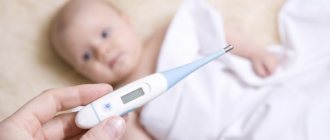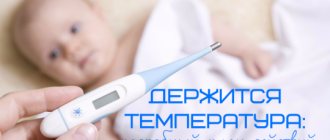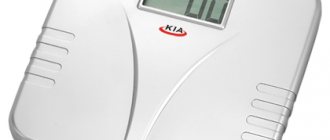Measurement Rules
Measurements of basal temperature must be carried out in a state of calm, when a person has been sleeping for more than 3 hours, preferably about 6-7 hours.
To measure, a thermometer is placed in the rectum, mouth or vagina. Temperature indicators are highly accurate, since there is practically no environmental influence. Measuring temperature is an important procedure that allows you to determine the presence or absence of pathologies, so the doctor’s request should be treated correctly.
The measurement method was invented back in 1953. It allows you to determine the correct functioning of the ovaries. After the measurements, a graph is drawn up. Based on the analysis, the specialist will draw a conclusion about your health.
To take measurements you will need a medical thermometer of any type. When taking measurements using a mercury thermometer, you need to wait 5 minutes. The electronic type will independently notify you of the completion of the procedure.
Basic Rules:
- The measurement is carried out daily, no exception on days with menstruation.
- You need to select a measurement location and spend all the time there, since when taking measurements in different places, some changes in the readings may occur. It should be carried out in the vagina, mouth or anus; under the armpit, the accuracy of the results will be questionable.
- The vaginal and rectal method requires inserting the narrow part of the thermometer into the passage for 3 minutes. The most common way is through the rectum.
- Measurements should be taken immediately after waking up; the person should not get up until the end of the procedure.
- Be sure to take measurements at the same time with a difference of no more than 1-1.5 hours. Every hour of sleep contributes to an increase in temperature by 0.1°.
- The duration of continuous sleep before measurements should be more than 3 hours. The information content of the readings with earlier measurements will be impaired.
- It is not recommended to change the thermometer within the framework of drawing up one schedule, even if it is based on the same element.
It is also necessary to observe:
- The mercury thermometer must be shaken off before installation, otherwise readings below the set mark will not be recorded. Insurance requires some effort, which may result in changes in indications. It is recommended to prepare the device in the evening and place it within reach, but the mercury type should not be stored under the pillow.
- Measuring basal temperature requires being in a lying, motionless position. Excessive movements are prohibited: turns, lifts, and rollovers interfere with the results. You can’t get up to get a thermometer, otherwise you don’t have to take your temperature—the procedure won’t bring any benefit. Sometimes experts recommend not even opening your eyes so that the light does not provoke the synthesis of hormones.
- The tonometer readings are taken as soon as the device is removed.
- Measurement results should be recorded to avoid confusion, since differences of a fraction of a degree can reduce the information content of the readings. If during measurements the indicator is between 2 marks, the lower one should be fixed.
- If there could be reasons for the change in temperature - illness, incorrect measurement, inflammation, etc., it is worth leaving a record of this.
- Changes may occur when taking measurements on business trips, during flights, during intimacy before bed, at night or in the morning.
- If you have diseases that provoke an increase in body temperature, the procedure will not allow you to obtain high-quality data and at this time you can take a break from measurements.
- Basal temperature can vary from taking medications, in particular sedatives, sleeping pills and hormonal drugs.
- The use of oral contraceptives during changes in basal temperature depends on the level and concentration of hormonal substances in the drugs.
- Alcohol consumption has a negative impact on the quality of measurements.
- If a person works at night, measurements are taken during the day.
How to measure correctly
To ensure accurate indicators, you should follow simple rules:
- BT must be measured at the same time. Choose the most suitable time interval for receiving data and stick to this schedule every day, since throughout the day, depending on the daily load, the indicators change and give inaccurate results.
- It is best to measure in the morning, without getting out of bed. This is necessary so that the measurements are shown with the body as calm as possible. With constant movement, BT increases, which will not be correct in maintaining the calendar. If you don’t have time to check in the morning, then before measuring your BT at any other time, you need to lie quietly on your bed for at least an hour.
- It is measured in the rectum for 3–5 minutes. It is better to use a mercury thermometer.
If your BBT remains at 37 C or higher for more than a week, you are most likely pregnant.
Basal temperature will show incorrect data if:
- Measurements are taken at different times of the day;
- Data measurement will be after the activity;
- Within 2 hours after sexual intercourse;
- Different thermometers are used;
- After taking hormonal drugs;
- During ARVI and other diseases with increased body temperature.
Normal during ovulation
There is no exact figure, since each girl has her own physiological characteristics. But, most often, BT should reach 37 degrees Celsius. This is a reliable sign of the onset of a favorable period for pregnancy.
The temperature during ovulation is below 37 C, if the difference with the first phase of the cycle is 0.3 C or more, this is normal.
How many days does it last after ovulation?
The released egg is viable for 24 hours. Therefore, for at least a day BT will remain above 37 C.
On the second day after the release of the egg, BT may drop by only 0.1 C, but this does not mean that the period for successful conception is over.
There are cases when the egg lives longer than a day, but this happens extremely rarely. Most often, elevated BT lasts for 48 hours due to the presence of the hormone in the blood after the separation of the egg from the ovary.
Before menstruation, BT may also increase, but this is not the period of ovulation.
What should the temperature be after ovulation, 37?
The temperature after ovulation always increases slightly, usually the changes are small, about 0.3°, so the figure slightly exceeds 37°.
The indicators increase gradually, this requires 2-3 days. In general, an increase of 0.1 to 0.3° is considered normal at this stage of the cycle. The high temperature continues until menstruation occurs. After bleeding, the temperature gradually decreases.
If an increase does not occur, and sometimes even a decrease is noted, this is an alarming signal that indicates the presence of certain abnormalities in the hormonal system. Except in cases where the decrease is due to other external factors or the measurement was carried out incorrectly.
In such situations, you need to contact a gynecologist to diagnose the pathology.
The normal basal temperature is 37° or a little more.
At low levels, progesterone deficiency may occur, which means pathology in the functioning of the reproductive system and conception becomes problematic.
Interesting! By keeping a basal temperature chart with high accuracy, you can find out the day when ovulation occurs. It is also possible to monitor the absence or occurrence of disorders and pathology in the reproductive system.
Types of graphs and rules for drawing up
Before finding out what the basal temperature should be after and during ovulation, let's consider the basic rules for taking measurements:
- carry out the analysis immediately after 5 hours of continuous sleep, remaining in a supine position, rectally;
- use one device, preparing and shaking it off in the evening;
- reach by the top;
- about the slightest deviation in the form of a cold, stress, alcohol consumption, medication, etc., make a note when recording the criterion.
To accurately determine the moment of fertilization, it is necessary to draw up a basal temperature chart to track changes in the body.
All indicators must be entered daily, then connect the dots to get your own curve. Experts identify several types inherent in this method:
- The difference in indicators in the first and second parts of the graph is not less than 0.4°C, two drops are clearly visible (before menstruation and in the middle). The increased basal temperature after ovulation lasts 12-14 days, this is how the standard two-phase period is characterized.
- There is a slight rise of 0.2-0.3 divisions of the thermometer in the second part. This indicates an imbalance between estrogen and progesterone towards a decrease in both.
- Basal temperature does not rise after ovulation, there is no premenstrual drop. The second period is shorter - about 10 days, but the difference of 0.4°C remains. This is a biphasic cycle with progesterone deficiency.
- Monotonous line throughout. The maximum basal temperature after ovulation of 36.9°C, without decreases or increases, indicates the absence of a cell (no rupture of the vesicle).
- A chaotic curve with large discrepancies in values most often indicates a lack of estrogen or the influence of some other factors.
A basal temperature after ovulation below 37°C most often indicates problems with ovulation, namely, insufficiency of the corpus luteum
How to make a schedule
For proper charting, it is necessary to record the correct readings based on the previously described requirements. If there are noticeable changes in readings due to external factors, a note must be made.
The graph should have columns:
- Day of the month.
- Day according to the menstrual cycle.
- Temperature.
- Notes – deviations and notes are entered here about why the temperature may have been incorrectly recorded or changed.
Thanks to such a simple form, it is possible to obtain complete information on basal temperature.
After drawing up a weekly chart, the points are connected to each other and a line appears that reflects the state of health.
You also need to know how to properly maintain a menstruation calendar.
Features of graph interpretation
Based on the temperature chart, you can judge how well the pregnancy is progressing. If after conception the basal temperature drops below 37.20C, this may mean that the fetus is not developing, this is observed with a frozen pregnancy.
A decrease in the curve on the graph indicates hormonal instability, and if you notice this sign in yourself, you should definitely consult a doctor. An increased basal temperature does not always serve as an accurate criterion; a change in the schedule can be caused by:
- inflammatory disease of the female genital organs;
- viral infection, cold;
- drinking alcohol the night before;
- too active sexual intercourse the previous night;
- incorrect measurement - after morning exercises, shower.
Pregnancy can be assumed if there is a sharp decrease in the temperature curve on the graph after ovulation. This change is called implantation retraction, and it is not always noted during pregnancy.
This feature of the basal temperature chart is observed on average in 25% of women who become pregnant. At the same time, in 10% of women, basal temperature may decrease temporarily even in the absence of pregnancy.
(votes: 4, rating: 5.00 out of 5)
Share the news on social networks
Ask a Question! You have questions? Feel free to ask any questions! And our staff specialist will help you. Go>>
Tags: conception
- Recommended Articles
- Is it possible to get pregnant before your period?
- Is it possible to get pregnant with uterine fibroids?
- At what age can you get pregnant?
« Previous entry
Reasons why it rises
Based on the graph, you need to divide it into 2 phases. The division is made at the location of the ovulation line (marked by a vertical line). So the first phase is the period before ovulation, and the second phase is the period after ovulation.
Estrogen deficiency
The reason for the decrease in the first period may be the estrogen hormone.
Due to the substance, indicators may be at the level of 36.2-36.5°. When the temperature rises to 36.5-36.8°, estrogen deficiency is often diagnosed. To eliminate the pathology, drug hormonal therapy is used.
Interesting! A deficiency of the same substance can lead to an increase in indicators in the next phase to more than 37.1°. The increase in temperature occurs more slowly than usual and lasts over 3 days.
Inflammatory process in the appendages
In this case, the increase in indicators occurs on a short-term basis. Even in the first half of the graph, 37° may be recorded, but then everything returns to normal. Determining ovulation in this case becomes difficult.
Interesting! There is no need to worry or sound the alarm if there is a sharp simultaneous increase in the indicator, since the inflammatory process cannot pass so quickly. With longer deviations, one can conclude that there is pathology.
Endometritis
In a healthy state, at the beginning of the measurement there should be a decrease in bleeding values.
If a person experiences a drop in temperature even before the end of the cycle, and then there is a repeated rise before the immediate start, endometritis is a potential cause.
Interesting! If the temperature has not dropped before bleeding begins, and the temperature continues to remain at the same level, pregnancy is likely, even taking into account the bleeding that has begun. You need to do a test and make an appointment with a gynecologist.
Is it possible to determine that fertilization has occurred?
The length of the menstrual cycle in different women can fluctuate by 2 weeks, but the changes are in the first phase. The second part of the cycle always lasts up to 12-14 days. A jump in temperature during ovulation indicates menstruation, but if this change continues for more than 2 weeks, it is a clear sign of pregnancy.
During pregnancy, menstruation does not occur, and the thermometer readings are always slightly higher than normal.
Interesting! If the basal temperature is lower, there is likely to be a deficiency of hormones that protect pregnancy and there is a risk of miscarriage.
Special tests for measuring basal temperature
Determining ovulation at home is possible using special tests. They are sold at any pharmacy, and using them is much easier and faster than measuring basal temperature rectally. Ovulation tests come in the form of test strips, in an amount of 5 pcs. in one package, and in the form of cassette tests, 7 pcs. packaged.
Test strips visually resemble pregnancy tests and work the same way. Before ovulation, luteinizing hormone increases, to which the test strip soaked in a special reagent reacts. A day before ovulation, the test strip will show changes in the female body, and they will be displayed in the form of two bright stripes on the test. The reliability of such verification is high and is about 99%.
To use the strip, you need to remove it from the package, place it in a glass with collected urine up to the limiter on the strip, and after a while you can see another line appear on the test: a bright line that appears will indicate the onset of the preovulation day.
Cassette tests are intended for women with irregular menstrual cycles, so there are 7 of them in a package, which is quite enough for test control. They work like regular test strips to determine ovulation.
Tests should be started on the 17th day from the start of the menstrual cycle. For example, if the cycle is 30 days, then you need to subtract 17 from these 30, the resulting figure (13) will be the day the testing starts.
The most suitable period for testing is from 10 to 20 hours during the day. When the test shows a positive result, you need to plan sexual intercourse in the next 3 days.
During ovulation, body temperature should be higher than on normal days. If on the approximate days of ovulation the basal temperature does not rise and this repeats every month, then you need to contact a gynecologist.
When should you worry?
Causes for concern arise when there are prolonged but small deviations in the schedule.
You need to respond to manifestations of shorter duration but greater intensity. It is recommended to carefully monitor your health if the temperature increases by more than 0.3° from normal values throughout the cycle. If the deviation is more noticeable (over 0.5°), it is worth taking a closer look at your health after 3-7 days. Any pathologies with health or conception are grounds for contacting a specialist.
When to see a doctor?
If a person follows the rules for measuring basal temperature and notices problems for more than 2 cycles in a row, it is worth making an appointment with a doctor and conducting a diagnosis to determine the condition.
The gynecologist pays attention to:
- The difference in indicators is more than 0.4° between phases.
- High marks throughout the cycle.
- Stably reduced temperature.
- The shortened stage is in the second phase, when the period is less than 10 days.
- Discharge of blood for no apparent reason in the middle of the cycle.
- Extensive menstruation lasting more than 5 days.
- Cycles lasting less than 21 days and more than 35 days.
- Graphs with controversial results and unclear expression of ovulation.
- Late onset of ovulation and inability to become pregnant for more than 2 cycles.
- Constant or frequent delays in the cycle, if pregnancy has not occurred.
- Anovulatory indications.
- Increased systemic temperature in the second part, lasting over 18 days, but without the appearance of hemorrhage and with negative tests for conception.
- High-quality graphs, where the period of ovulation is clearly defined, and regular acts of intimacy were carried out at a given time, but without conception for several cycles.
Basal temperature during ovulation is an informative method for determining health, the onset of ovulation or pregnancy, you just need to adhere to the rules for drawing up a schedule and report deviations in the system in a timely manner.
Basal temperature during early pregnancy
BT analysis is often carried out at the initial stages of an interesting situation in order to early identify various pathologies. Basal temperature during pregnancy in the 1st trimester is located at the upper limits. Basal temperature after ovulation, if fertilization has occurred, can exceed 37°C. During an ectopic pregnancy, it does not change, so it is impossible to diagnose pathology with its help. If the indicator decreases, then the woman should wait for her next menstruation. There is also a risk of miscarriage.
Basal temperature before menstruation
In the second half of the menstrual cycle, it is very difficult to diagnose pregnancy using the BT schedule. An increase in indicators may indicate both successful conception and the imminent onset of menstruation. Which BT dominates before menstruation depends on the characteristics of the body and factors affecting the body from the outside. As a rule, it is less than 36°C. Basal temperature during menstruation ranges from 36.3 to 36.5°C. BT after menstruation begins to gradually increase, but does not exceed 37°C.
Basal temperature after IVF
The course of pregnancy after in vitro fertilization is not much different from normal conception. All processes in the female body during this period proceed according to a certain pattern. The only difference is that a woman needs support in the form of medications containing hormones.
In Vitro Fertilization
BT after embryo transfer after IVF decreases to minimal values. During this period, the fertilized egg is attached to the body. This process may take 1-2 days. BT after IVF is monitored day by day to determine the dynamics of embryo engraftment into the uterine cavity.
How does alcohol affect basal temperature?
At the stage of planning a child, it is better to abstain from drinking alcohol. But sometimes a woman allows herself a glass of wine before going to bed. You should remember the effect of alcohol on basal temperature. It increases temperature readings, which can distort the reliability of the study results.
Basal temperature for ovarian cysts
Cystic formations in the epididymis can become a serious obstacle to pregnancy. Therefore, it is necessary to detect them as early as possible, preventing possible complications. One of the signs of deviation is an increase in BT levels. On the finished chart it will be high throughout the entire cycle. Menstruation will be delayed. With a cystic formation in the corpus luteum, the increase in BT can be significant. This is due to the intensive production of progesterone.
Implantation drop in basal temperature
On a graph based on BT, you can trace the period of implantation of the fertilized egg into the endometrium. This will help diagnose pregnancy in a timely manner and monitor the growth of hCG. On what day the implantation retraction of the BT occurs depends on the speed of movement of the embryo and on when ovulation occurred. On certain graphs it is quite difficult to detect implantation retraction of BT. It is impossible to predict by how many degrees the indicator decreases. Typically there is a range of 3-5°C.
implantation drop in basal temperature on the chart
Duphaston and basal temperature
When planning a child, some women are prescribed Duphaston. This drug contains progesterone, which helps keep the fertilized egg in the uterus. It acts on the body in a similar way to a hormone produced by the adrenal glands and the corpus luteum. It is not difficult to guess whether duphaston affects basal temperature. It increases significantly as the drug introduces the ovaries into the luteal phase.
Basal temperature during menopause
With the onset of menopause, a woman's reproductive system undergoes hormonal changes. It affects the operation of all life support systems. Therefore, many women are faced with the question of what kind of BT during menopause. Ideally, it should be located at approximately the same level, in the range from 36.8 to 37°C. A sharp increase in temperature can be caused by the following factors:
- Endocrine diseases;
- Blood pressure surges;
- Lack of sleep;
- Inflammatory processes;
- Colds and ARVI.
In rare cases, ovulation occurs during menopause. In this case, characteristic changes in BT will be observed. We can also talk about gynecological diseases. During menopause, the risk of developing fibroids, condylomas and infectious diseases increases. This is due to a decrease in the body's defense mechanisms.











